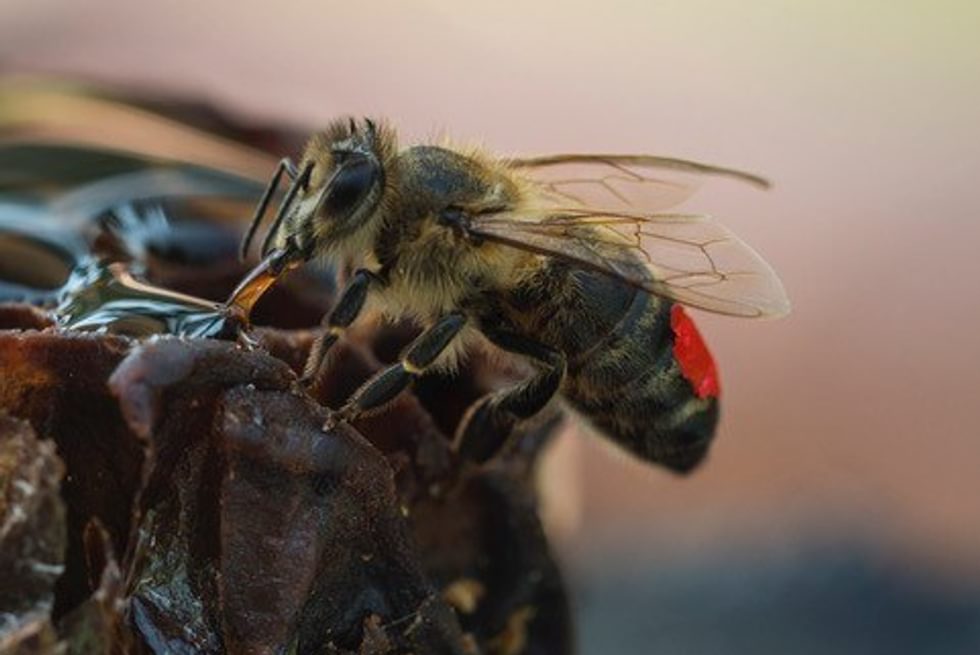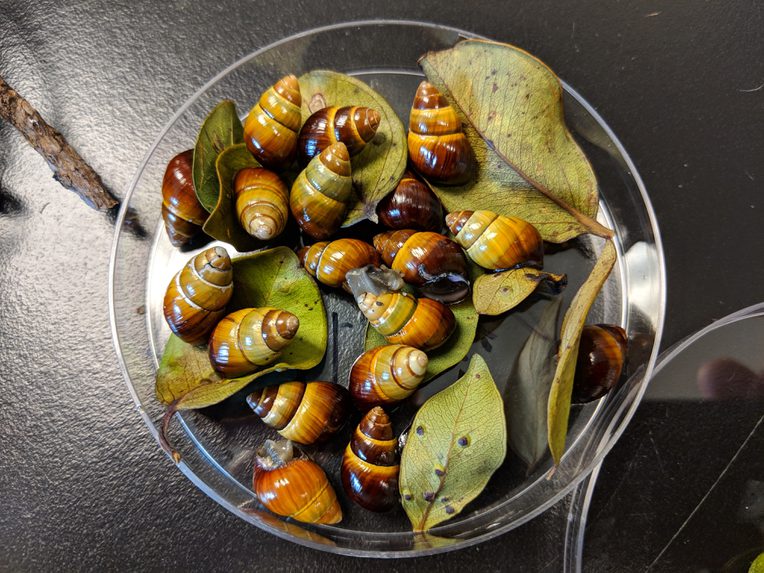Mourning as Care in the Snail Ark
From the Series: Multispecies Care in the Sixth Extinction
From the Series: Multispecies Care in the Sixth Extinction

We stood gathered around the workbench counting snails. The adults were easy enough to spot among the vegetation in front of us. The juveniles, however, were a different matter altogether. Their tiny forms, not more than a couple millimeters in length, could easily be mistaken for a mark on a leaf or branch. Every piece of vegetation had to be checked twice, by two different people. In all, forty tree snails were identified in this particular container, eighteen adults and twenty-two juveniles. As we finalized the count, the snails now gathered into two Petri dishes, I got a closer look at their incredible brown-green shells, glistening under the laboratory lights.

This was my first encounter with Achatinella lila. The last known free-living population of the species disappeared from the forests of O‘ahu a couple of years ago. All that remains of the species is now found here, in the captive breeding lab of the Hawaiian Snail Extinction Prevention Program (SEPP). While another thirty-seven rare snail species also make their homes here, this is ultimately a small sampling of the islands’ threatened land snails. Of 754 recognized species, well over half are thought to already be extinct, and most of those that remain are in severe decline.
The causes of this decline are complex. Two centuries of habitat loss to ranching, plantations, and the military have taken their toll. As did a long and spirited period of shell collecting beginning with the arrival of Christian missionaries in the 1820s (itself a strange practice of care, if not for the individual snails, then for their beautiful shells and the knowledges that might be produced with them). Today, the remaining snails are being eaten out of the world by a range of introduced predators, including rats, chameleons, and a carnivorous snail (Euglandina rosea). This last predator, introduced as a failed biocontrol agent in 1955, ignored the intended target snails and instead turned its attention, along with its disturbingly efficient ability to track slime trails, toward the locals.
Keeping thousands of captive snails healthy in the lab is a detailed, time-consuming work of care. In this facility, groups of snails live out their lives in plastic containers, each stocked with the appropriate vegetation and stored within one of several large environmental chambers that replicate the temperature and moisture conditions of various parts of the Hawaiian forest. Every two weeks each container needs to be taken out, its inhabitants censused, before it is cleaned, sterilized, and replenished. As the captive population has grown, this has become a Sisyphean task: when the last container has been cleaned, it is time to begin again with the first.
This lab is an ark of sorts: a place of care where snails might weather the Anthropocene storm. But there are no guarantees. Tellingly, the SEPP program is explicitly one of “extinction prevention” rather than recovery or restoration. As Dave Sischo, the manager of SEPP, explained to me: “For the next decade, I foresee that our role as a program is just preventing extinction. We’re essentially manning the lifeboats.”
But the sad reality is that for most of the species in the ark, we cannot even imagine the concrete steps that might make possible a life beyond its walls. Any such plans would require the widespread eradication of Euglandina rosea; yet another instantiation of the widespread violent-care that enables futures for some through the suffering and deaths of others (van Dooren 2014; see also Celermajer and Wallach, this series). There are no real plans for how to achieve this goal, whether practical or purely speculative. The best that can be done for now is to hold onto rare snails in case something changes.
What happens to practices of care in times like these? Specifically, what does it mean to care for species as their recovery becomes a less and less realistic prospect? How does this situation change what care might do and be? Perhaps, alongside the concrete daily acts of feeding, cleaning, and censusing that are keeping snails alive in the ark, we are called to care as a work of mourning; a work of bearing witness, of keeping faith with the dead and dying, of reckoning with what has been and will still be lost.
Deborah Bird Rose (2011) taught me about the obligations of witness in the face of extinction. In the first instance, to bear witness is an act of faithfulness to individuals and species whose worlds we, collectively, have destroyed. But it is also an act of faithfulness to all those who must now live out their lives in plastic containers and to the larger forms of species life that they carry with them toward the edge of extinction. In this context, doing the work of holding on to species for as long as we can—provided that they are living flourishing lives—might be understood as an effort to cultivate some semblance of responsibility (alongside the knowledges needed to really understand what matters to snails, cf. Haraway 2008, 91–93). To refuse to take responsibility at this time would be to inflict a second violence: to add our knowing indifference to the carelessness and disregard that brought them to the edge of extinction.
But to bear witness is also to share this knowledge with others, to refuse to be silent in the face of death and extinction. This too, is a work of mournful care, of articulating the complexity of what is lost as these snails withdraw from the forest and then disappear from the world altogether. These are stories of unique and precious ways of life, of snail sense-making, reproduction, and sociality. But they are equally stories of ecological change, of forests missing their detritovores, and of impacts on Native Hawaiian relationships and stories that, for example, tell how these snails once sang in the forest at night. In this context, mourning as care is a work of learning to acknowledge, to tell, and ultimately to dwell with these multi-faceted and ongoing processes of loss. This, it seems to me, might be a vital “art of living on a damaged planet” (Tsing et al. 2017). It is also a work that is facilitated, or at least prolonged, by the ark itself. Among its many other roles, the ark opens up a space in which we might confront these beings who stubbornly go on living even after their worlds and possibilities have been so systematically destroyed.
Haraway, Donna J. 2008. When Species Meet. Minneapolis: University of Minnesota Press.
Rose, Deborah Bird. 2011. Wild Dog Dreaming: Love and Extinction. Charlottesville: University of Virginia Press.
Tsing, Anna Lowenhaupt, Nils Bubandt, Elaine Gan, and Heather Anne Swanson, eds. 2017. Arts of Living on a Damaged Planet: Ghosts and Monsters of the Anthropocene. Minneapolis: University of Minnesota Press.
van Dooren, Thom. 2014. Flight Ways: Life and Loss at the Edge of Extinction. New York: Columbia University Press.